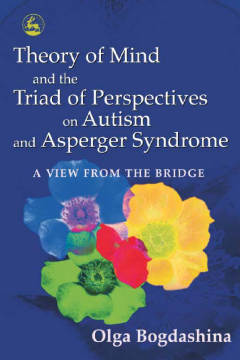
BOOK
Theory of Mind and the Triad of Perspectives on Autism and Asperger Syndrome
(2005)
Additional Information
Book Details
Abstract
Inspired by the often uncomfortable interplay between autistic individuals, parents and professionals in understanding autistic spectrum conditions, Olga Bogdashina uses the concept of Theory of Mind (ToM) to consider these groups' different (and often conflicting) perspectives.
ToM is the ability to imagine and make judgements about what others feel and think; its absence in autistic individuals is called 'mindblindness'. This book addresses the 'mindblindness' of people united in their interest in autism but divided by their different angles and perspectives. Divided into four parts, the book first defines autism, then the views of the three main groups working with it - autistic individuals, parents and professionals - under the headings of classifications, diagnosis, causes, development, theories and treatment. By comparing and reconciling the different perspectives in this way, the book helps each group to understand and predict each other's responses and behaviours.
This enlightening and innovative book offers a unique way of 'stepping in each other's shoes' and is a valuable resource for all people living or working with autism.
This book was written by a professional working in the field of autism as a teacher, lecturer, and researcher, who is also the mother of a child with autism spectrum disorder (ASD). The aim of the book is to improve the quality of life for those whose lives are touched by autism, that is, parents of individuals with ASDs, individuals with ASDs, and professionals who work with these individuals, and their families. This is achieved by providing an opportunity for them to "step into each other's shoes and walk around for a while". The author develops a theory of (different) minds (including a theory of autistic mind (To AM), from the familiar concept of theory of mind (ToM) that facilitations this process. The book provides a wealth of information on all aspects of autism thus providing a comprehensive guide for those new to autism and/or a valuable resource for those familiar with ASDs. In particular it provides a welcome addition to the relatively small corpus of literature written from the perspective of individuals with ASDs or Asperger Syndrome. The book is well researched and the sections on further reading particularly useful for those wanting to know more.
Educational Psychology
An excellent and well-written book... which should be on the shelves of every mental health professional who has an interst in ASD.
Asperger United
Theory of Mind is the ability to imagine and make judgements about what others feel and think; its absence in autistic individuals is called 'mindblindness'. This book addresses the 'mindblindness' of people united in their interest in autism but divided by their different angles and perspectives. Divided into four parts, the book first defines autism, then the views of the three main groups working with it - autistic individuals, parents and professionals - under the headings of classification, causes, development, theories and treatment. By comparing and reconsiciling the different perspectives in this way, the book helps each group to understand and predict each other's responses and behaviours. This enlightening and innovative book offers a unique way of 'stepping in each other's shoes' and is a valuable resource for all people living or working with autism.
Link, Autism-Europe
Olga Bogdashina, MA Education (Autism), PhD (Linguistics) has worked extensively in the field of autism as teacher, lecturer and researcher, with a particular interest in sensory-perceptual and communication problems in autism. Since 1994, she has been the director of the first Day Centre for autistic children in Ukraine and the President of the Autism Society, Ukraine. Olga teaches and lectures around the world. She is currently a Visiting Lecturer at Birmingham University and Consultant Psychologist for Services for Adults with Autism, Doncaster, UK. She has a teenage autistic son.
Table of Contents
| Section Title | Page | Action | Price |
|---|---|---|---|
| Introduction | |||
| 1. Understanding disaster risk reduction and climate change adaptation | |||
| 2. Key groups for disaster risk reduction and climate change adaptation | |||
| 3. Program cycle management for disaster risk reduction and climate change adaptation | |||
| 4. Key sectors for disaster risk reduction and climate change adaptation | |||
| 5. Key contexts for disaster risk reduction and climate change adaptation | |||
| 6. Creating an enabling environment for disaster risk reduction and climate change adaptation | |||
| Tools and Resources | |||
| Glossary | |||
| Index |
